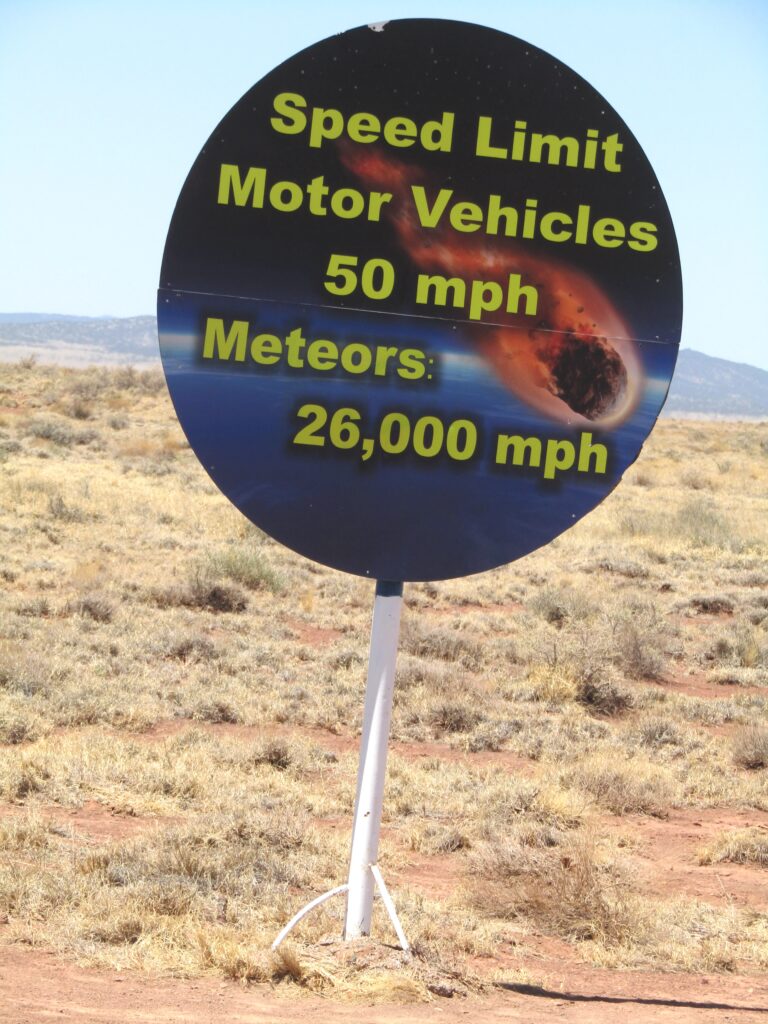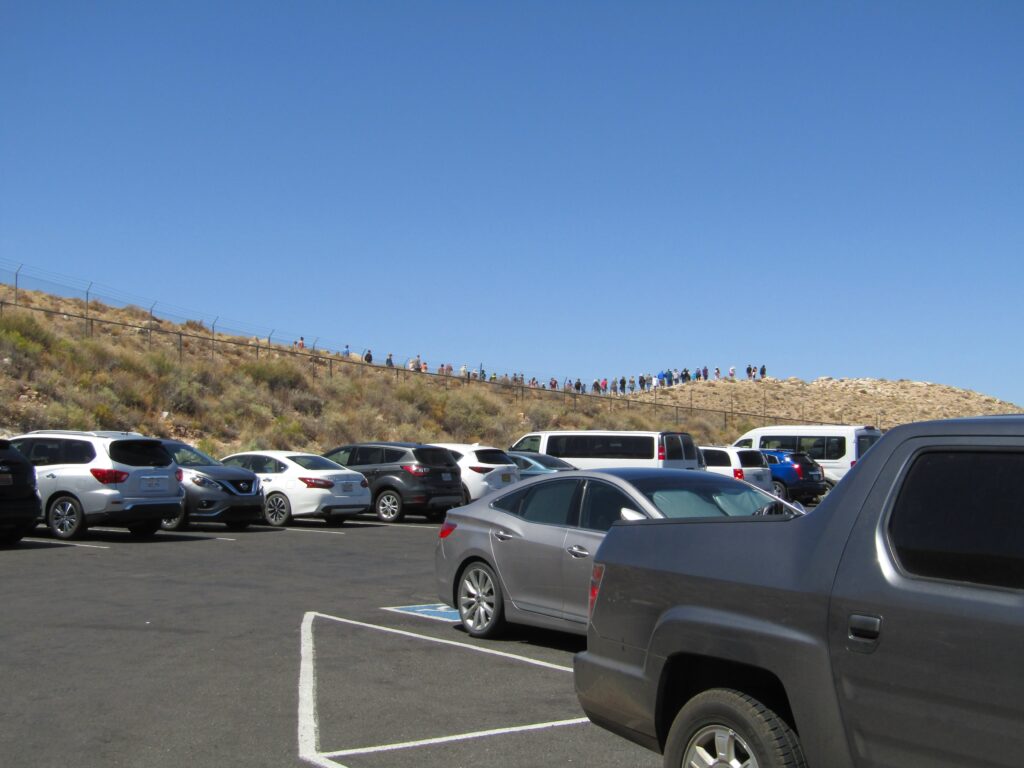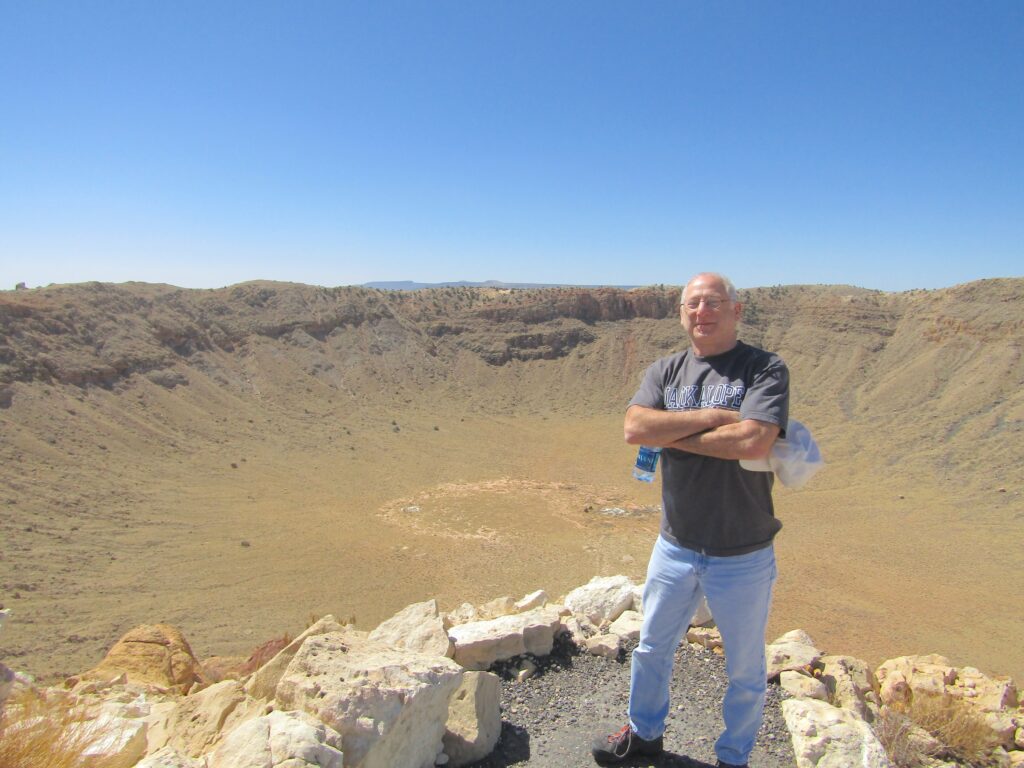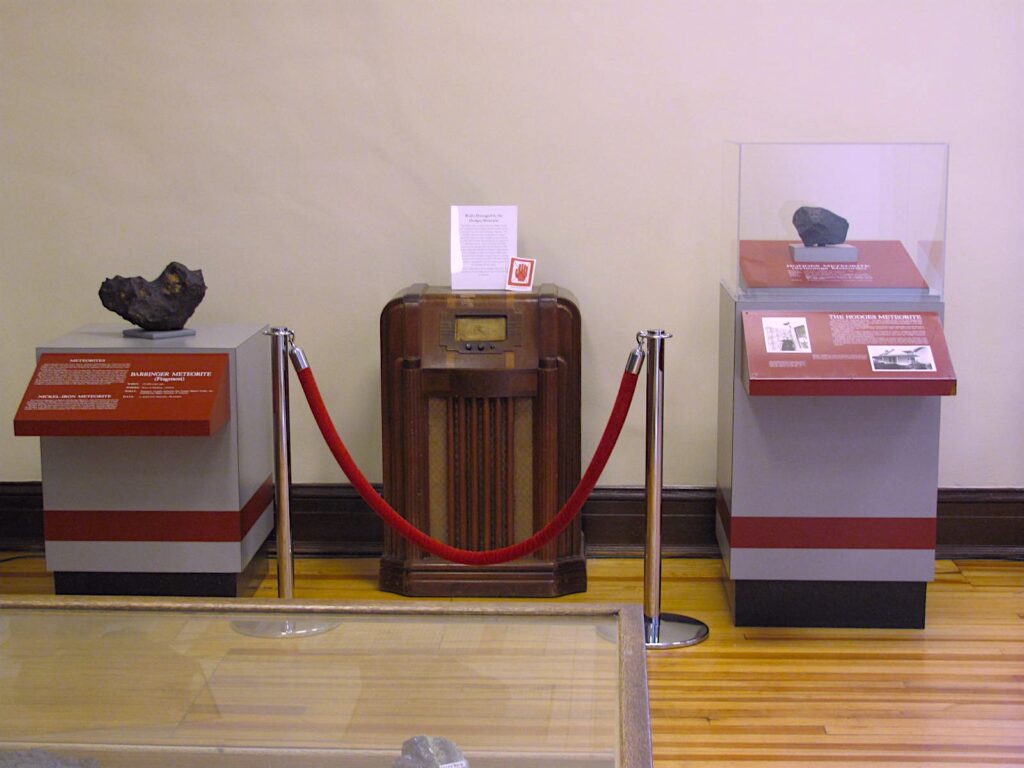outside Flagstaff
Arizona
May 2018

Lisa is not the only one who has been caught speeding in Arizona.
In 1871, two years after John Wesley Powell explored the Grand Canyon, scout for the United States government Franklin Benitez was charged with surveying a remote region in the Arizona Territory. Coming upon a sizable depression in the ground, Benitez’ report back to General George Armstrong Custer consisted of two short sentences. He wrote, “There’s a hole. It’s big.”
Perhaps we should start when Earth first got involved. Fifty thousand years ago, give or take twenty minutes, there was a calm over the flat plains in this Arizona area. A few minutes later, it became very noisy. That’s what happens when a big thing hits a bigger thing at 26 000 miles per hour. It became noisy, and quite a mess. Also hot and full of dangerous projectiles. What happened was, a big ole rock, maybe 150 feet across, fell out of the sky and smashed into the ground. It left such an impression that curious tourists, like us, 50K years later, still come to look at it.
When all the tumult was done, what was left was a round divot about 4200 feet from rim to rim and 700 feet deep. Let’s do a football comparison, because that’s what the folks at Meteor Crater Enterprises, Inc do…
size of meteorite
from the goal line to the fifty yard line
diameter of crater
roughly 14 football fields end to end
depth of crater
2 football field lengths plus an extraordinarily long field goal
number of football fields you could put inside the crater
20
number of fans who could fit if the crater was a stadium
more than two million
More than two million!
One wonders why some entrepreneur hasn’t bought up the place and turned it into a football arena.
I never said that.
How do you dig such a gigantic arena? I’m told that the force of the explosion was equivalent to 20 million tons of TNT. This is a large number of TNTs, but pretty much meaningless to me. So is the statistic that the force of impact generated more than 20 million pounds per square inch of pressure on the ground at the impact site. What does this mean in real life? Maybe the force of all those large football players running into each other while playing twenty games simultaneously is comparable.
Meteor Crater is the first crater on our planet proven to have originated from the impact of a meteorite. It took some time to get to this conclusion and stories abound concerning the validity of this fact. Here is some of the history.
1891
Grove Karl Gilbert studies what was called Coon Mountain, 35 miles east of Flagstaff, Arizona and suggests that the depression was caused by a gas explosion.
(There is a real Coon Mountain 97 miles to the southeast as the crow flies, but this just complicates things. Ignore this.)
1902
Daniel Moreau Barringer, hanging out in a Tucson theater lobby, overhears some ranchers chatting about chunks of iron they found by a large crater in the high desert of Arizona. With dreams of dollar bills winging their way into his life, Barringer forms a company to mine the crater.
1903 – 1929
Barringer drills and drills. He drills here, he drills there. Even though Barringer believes wholeheartedly that a big ole iron rock crashed here, it gets to the point where, with no iron making an appearance, the theory that an ancient steam volcano caused the depression seems more and more likely.
But Barringer, certainly a man of perseverance, continues his search for what he imagines is ten million tons of iron, worth many hundreds of billions of dollars. He drills on.
1929
Astronomer Forest Ray Mounton calculates that most of the meteorite had vaporized upon impact and that small chunks of iron were scattered for miles around the site, nothing significant. He finds no large iron deposit because there is no iron deposit to be found.
Dan Barringer, you’re a putz. You spend far more than half a million dollars and 27 years trying to mine the iron out of the ground. As you discover after blowing almost all of your family’s assets, there ain’t no iron!
Investors pull out of the search project. Daniel Barringer dies. His family then forms the Barringer Crater Company.
1958 – 1959
A crater on the dark side of the moon is named for Daniel Barringer. The crater is called “Barringer.” Hoo-rah!
While Daniel Barringer always believed that the hole was what was left of a space rock collision, it took Eugene Shoemaker to lay rest to any controversy concerning the origin of the crater. He determined that this depression was, definitively, from a meteor impact, not a gas explosion, not a volcano.
I am personally excited to learn about Gene Shoemaker’s contribution to our understanding of Meteor Crater. My first hearing of him was in 1993 and had to do with Comet Shoemaker-Levy 9. Gene and his wife Carolyn along with astronomer David Levy discovered that a comet had been ripped into fragments by tremendous tidal forces (gravity) when it passed close to the planet Jupiter. The fragments were on a course to collide with the king planet and these three scientists predicted the collision. Such an observation had never been made before. Knowing of the impending collision, this was the chance to see what would happen when these comet pieces crashed into the planet at a speed of 37 miles per second. Yowie!
The explosions would be the largest ever seen on any planet. Just one of the larger impacts generated enough energy to supply all that humans could need for the next 50 000 years. It released an amount of energy equivalent to 400 000 000 Hiroshima sized atomic bombs. It was hotter than the sun.
This science story actually was important enough to make headlines. Take that, you anti-science goofballs!
Lisa and I are considering a tour of the impact craters on Jupiter formed by the collision of Comet Shoemaker-Levy 9, but at this time, it’s low on our list, mainly due to logistical problems in getting there.
Dr Shoemaker always wanted to fly to the moon. He did finally get his wish but unfortunately, he was dead when he made the flight. He rode the Lunar Prospector spacecraft, launched in 1998 and impacted on the moon a year and a half later. He is still the only Earthling buried on the moon.
Whatever image you may have in your mind of strapping in a corpse to the seat of the Lunar Prospector… Erase it. It was his ashes that made it to Luna.
Another crater we will not visit.
Riding along with Gene Shoemaker (ashes) on the spacecraft was a brass foil inscribed with an image of Comet Hale-Bopp, an image of Meteor Crater and this passage from Romeo and Juliet…
And, when he shall die,
Take him and cut him out in little stars,
And he will make the face of heaven so fine
That all the world will be in love with night,
And pay no worship to the garish sun.
Why the image of Hale-Bopp? Seems that Eugene and his wife, Carolyn, were involved in a car accident. Eugene died, Carolyn was injured but lived. Comet Hale-Bopp was the last comet they observed together.
Good backstory. But we’re here now for this particular hole in the ground. Meteor Crater is no big deal if you overview the solar system. Meteor impacts are very common among celestial bodies. Very. Just look at the surface of our moon.
Earth is no exception. How many meteors hit our home planet? That’s easy. None.
Okay, I’m just messing with you. Meteors disintegrate in Earth’s atmosphere and never make it to the ground. But the ones that don’t burn up and actually make it, we call them “meteorites.”
But still, how many? Actually, about 48.5 tons of space crap fall out of the sky each day and collide with Earth. That’s the equivalent of seven Tyrannosaurus rex, or 10 000 house cats. Most of the space stuff that falls to Earth is teeny, tiny, way smaller than a cat, and we don’t notice it at all.
(Y’know how we know that the Earth is not flat? If it were, cats would have already pushed everything off the edge.)
Only the largest meteors have enough material to last through the fiery journey through the atmosphere. Some of these, occurring every two thousand years or so, are large enough to make a difference, meaning, they punch a large hole in the ground.
But then there are the big ones, two of which are most famous. About 65 000 002 years ago, give or take twenty minutes, a rock somewhere between 300 000 000 000 and 3200 000 000 000 tons fell on the Yucatan Peninsula, creating the Chicxulub Crater. It killed about 75% of the animals on Earth, including the dinosaurs.
The other famous falling was our friend, the Barringer Meteorite, which fell to Earth about 50 002 years ago.
Some quick stats…
. every infinitesimally short moment, an infinitesimally small rock burns up in the atmosphere
. every 30 seconds, a one millimeter piece burns up in the atmosphere
. every year, a one meter piece (39 inches) bursts in the air, not making ground fall
. every 10 years, a ten meter piece (33 feet) bursts in the air with some pieces landing
. every 1000 years, a 100 meter piece (a football field including one end zone) bursts in the air and creates great damage
. every 100 000 000 years, a 10 kilometer piece (6.2 miles, one standard foot race that takes an average of 60 minutes to run) creates planet-wide destruction and mass extinction
Okay now, back to our famous meteorites. A third one, very well-regarded around my household, is the one that crashed into Ann Hodges’ hip in Sylacauga, Alabama in 1954.
Besides being invented for the pleasure of geeks and nerds, here’s another reason we should be kind to meteors and meteorites. A theory known as “panspermia” tells us that life is everywhere throughout the Universe and it is ferried about by various celestial bodies like meteors, comets, space dust and other rocky things out there. Amino acids, which make up proteins, have been discovered on comets. Whoa! By crashing into the Earth, say the panspermiacs, life was seeded on our planet. In other words, this is where life on Earth came from. According to these folks.
Joni Mitchell sang…
We are stardust
Billion year old carbon
Meteor Crater is one of the training locations for all the Apollo astronauts who have walked on the moon. All kinds of scientists spend time here: geologists, physicists, students, explorers, researchers and astronomers. This is the best-preserved meteorite strike in the world.
Although not scientists, we go too. Lisa and I drive west on I-40 from Winslow and make a left turn onto — strangely believe it — Meteor Crater Road. A few minutes drive takes us to the parking lot. We enter the building and buy our passes. Stapled to the receipt is a coupon for the Subway sandwich shop. Bonus! We are now two of the 300 000 visitors they see each year. That’s a lot of hoagies.
Why Subway? I wonder. I’m sure it has nothing to do with the fact that both the meteorite debris and the subway are underground.
We wander around, climbing up and down the metal staircases erected to keep tourist footsteps from damaging the integrity of this pristine crater. We view the hole from every angle they allow. We are not permitted to go down into the crater and we may not walk around the circumference. We do however take the tour, half a mile out a trail on the rim with a running commentary by Kristen who is a part-time ranger and a full-time teacher and our guide for today.

Way down there in the center of the crater are some structures. Kristen tells us they are the original mine shafts dug by Daniel Barringer himself.

Years ago, Lisa and I knew there was a meteor crater in Arizona and had decided that one day, we would visit it. The first time we heard about the Barringer Crater, we were in, of all places, Tuscaloosa, Alabama, 1521 miles east of the rock landing as the crow drives, 1347 miles as that bird flies. Specifically in November of 2013, we were touring the Alabama Museum of Natural History on the University of Alabama campus. Our object of interest was the Hodges Meteorite, so named because this particular hunk of space rock crashed through a roof, bounced off a radio and smacked Ann Elizabeth Hodges right on her hip, in her very own home!
Ann Elizabeth Hodges lived in Sylacauga, a couple of hours from the museum. Yes, we went to the museum for the express purpose of viewing this meteorite, the only meteorite that we know for sure actually struck a human person in the history of meteorites and human persons.
There it is, to our right, in its display case along the back wall. In the center of the three is the radio that got hit just moments before Ms Hodges did.

Note that there in its own display case to our left of the radio is the “Barringer Meteorite,” one that actually fell in Arizona.
Now, we are standing on the rim of the Barringer Crater in Arizona. The mother ship that brought the little rock eventually to Tuscaloosa landed here, some 50 000 years ago, give or take twenty minutes, I’m not sure, I wasn’t here.
We are on the tour and I am all proud of myself, telling our tour guide that we saw part of this meteorite in Alabama. She responded without great enthusiasm, “Oh yeah, there are pieces of this thing all over the world.”
But wait. Poor Ann Hodges got smacked by a falling rock in Sylacauga in 1954. What are the chances that will happen to you? Behold, some useful probabilities…
The chances that you will be in a motor vehicle accident in your lifetime are 1 in 90, twice as likely as dying by falling. Lose your life by drowning? One in 9000. Flood? Three times less likely. A tornado? Twice again as unlikely.
One study shows that you have a 1 in 100 000 chance of dying while attending a dance party. Lose your life in an earthquake? Slightly better odds at 1 in 130 000.
Lose your life by lightning strike? 1 in 135 000. (Mom, I still think you should have let me climb up on the roof to get a better look at the thunderstorm.)
Die by being attacked by a shark? 1 in 8 000 000. One in eight million! Plus bragging rights.
Likely you won’t lose your life from winning the lottery, but to keep things in perspective, your chances of winning are 1 in 195 249 054.
But what about dying as a result of getting conked by a meteorite? Now you’re talking. Depending on which expert you believe, there is a 1 in 1 600 000 chance. Or a 1 in 75 000 chance, 1 in 250 000 possibility, and my favorite, 1 in 74 817 414. We’re talking death here. I remind you that Ms Hodges was hit by the meteorite but did not die.
One thing often not explained is whether you get killed personally by actually being struck by the rock, or whether the killing is less selective, as when it is large enough to kick off planet-wide destruction and mass extinction, including you.
Personally, I think these numbers are hooey. Ann Hodges may not have been the only person with the honor of rudely meeting a meteorite with her name on it, but all reports of other impacts are unconfirmed. Given how few times a meteorite has been large enough to kill people, I think your chances are way less than these researchers submit.
Oh, depending who you believe, your chances are slightly greater of dying from a dog bite than from a meteorite strike…
…according to the internet.
But don’t pooh-pooh the numbers. If you are out one day minding your own business and you find yourself caught in a meteorite shower, the ones that actually hit the earth, quick, go buy a lottery ticket. As long as you don’t have to get around an aggressive dog, or a shark. You’ll be safer.
